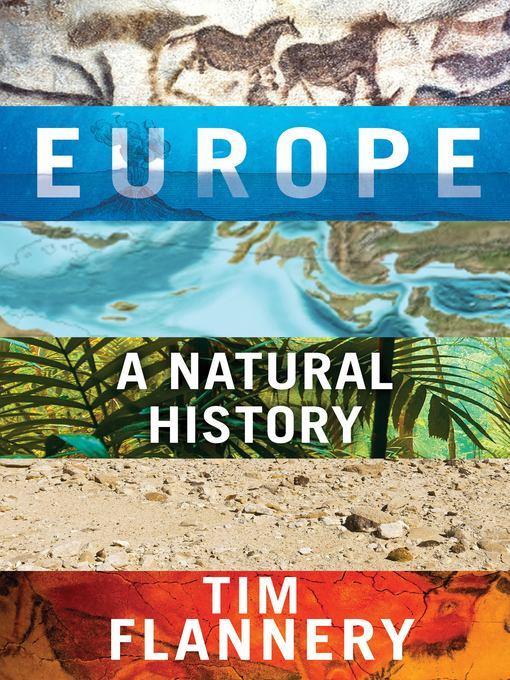
Europe
A Natural History
کتاب های مرتبط
- اطلاعات
- نقد و بررسی
- دیدگاه کاربران
نقد و بررسی

Starred review from October 29, 2018
Paleontologist Flannery (Atmosphere of Hope) pulls back the curtain on Europe’s past environments, while also giving a glimpse of its possible future, in this marvelous work. Flannery begins 100 million years ago, when dinosaurs still walked the Earth and Europe was a “tropical archipelago.” In this and each following section, Flannery introduces readers to the species that coexisted during a particular epoch, ranging from the very small to the very large and always including examples of the very strange, such as the “hell pigs” of the Oligocene period, between 33 million and 23 million years ago, or the Deinogalerix, the largest hedgehog to ever live, during the Miocene, between 23 million and five million years ago. Flannery also tracks the ebb and flow of less exotic species, such as relatives of bears, elephants, giraffes, and humans, and, throughout, shares a plethora of surprising facts, such as that “falcons and robins are more closely related to each other than are
falcons and hawks.” In the final chapters, Flannery discusses the prospects for “rewilding” Europe—perhaps by importing once-native species, including lions and elephants. Beyond this book’s obvious appeal to conservation-minded Europeans, it should attract any reader interested in the past and future of the natural world. Agent: David Forrer and Kim Witherspoon, InkWell.

Starred review from December 1, 2018
Chief councilor of the Australian Climate Council and paleontologist Flannery offers a definitive natural history of Europe from 100 million years ago to today's climate- and extinction-driven efforts to rewild. Transporting readers to meticulously described times and places, the author imparts micro and macro views of Europe that depict an Asian peninsula where human migration moved westward but that took its greatest innovations from its eastern neighbor. At the micro level are details such as those concerning the DNA of horses, which shows that the first herd had few stallions. Moving to a much wider view, Flannery describes, for example, the development of agriculture and animal husbandry in Europe. Throughout, the author employs crisp, lively language suitable for readers without a background in natural history; the level of research and detail, however, means that it can also be used as an uncommonly approachable natural history textbook. VERDICT An excellent choice for public and academic libraries. [See Prepub Alert, 8/13/18.]--Henrietta Verma, Credo Reference, Jackson Heights, NY
Copyright 2018 Library Journal, LLC Used with permission.

November 15, 2018
A noted paleontologist traces Europe's land, flora, and fauna over 100 million years.Australian explorer and conservationist Flannery (Atmosphere of Hope: Searching for Solutions to the Climate Crisis, 2015, etc.), chief councilor of the Australian Climate Council, offers a fascinating geological and natural history of Europe, from its origins as a tropical arc of islands to the present, as the world faces the challenges of rapidly rising temperatures. European biodiversity, writes the author, has been "destroyed and re-made three times over as celestial and tectonic forces shaped the land." He depicts in colorful detail the variety of wildlife inhabiting the islands along with dinosaurs, including primitive mammals, and strange creatures, such as pythonlike snakes, terrestrial crocodiles with serrated teeth, and "large side-necked turtles." Today, the midwife toad--a species in which the male gathers up and protects the eggs--represents Europe's oldest vertebrate family, a survivor of 100 million years of geological catastrophe, including the devastating asteroid crash that precipitated a nuclear winter and, some scientists argue, caused the extinction of dinosaurs. Besides revealing many examples of bizarre animal life--the blind salamander that spends its entire life in caves, for example, and the perissodactyl, an animal with a horselike head and gorillalike body and limbs with huge claws--Flannery traces the migration of fauna between Africa and Europe. About 12 million years ago, he asserts, "the faunas of Kenya and Germany became almost indistinguishable." Among the fauna were the earliest hominids, which appeared in Europe at least 1 million years earlier than in Africa, although genetic analysis confirms that the genus Homo did evolve in Africa, later migrating to Europe. Around 38,000 years ago, Europe became colonized by a "hybrid human-Neanderthal population." Today, Flannery concedes that a healthy population of carnivores, larger herbivores, and scavengers is making Europe "a wild and environmentally exciting place," but he cautions that efforts at "rewilding" need to be carried out with responsible scientific oversight and that indisputable global warming has real impact.An illuminating natural history and warning for the future.
COPYRIGHT(2018) Kirkus Reviews, ALL RIGHTS RESERVED.

January 1, 2019
Paleontologist and best-selling author Flannery (Atmosphere of Hope, 2015) mediates the scientific literature on Europe's geological and zoological history in a sweeping survey of the region's past 100-million years. Beginning with how plate tectonics shaped the land, Flannery explains how scientists read and interpret the fossil record. This leads to portraying the fauna of each formal segment of recent geological time, including predators and small amphibians and mammals. Cautioning that fossil evidence is fragmentary and partial, Flannery nevertheless revels in the findings in significant deposits that enable scientists to track evolution. The details sharpen the closer Flannery comes to the ice ages, which ended about 11,000 years ago, and the emergence of the planet's top predator, humans. The arrival in Europe of Homo sapiens and the concomitant extinction of the Neanderthals and large animals like the mammoth heralded drastic changes to the European landscape that continue to this day. Coverage of efforts to reintroduce lost flora and fauna rounds out Flannery's impressive, significant, and edifying ecological history.(Reprinted with permission of Booklist, copyright 2019, American Library Association.)

























دیدگاه کاربران